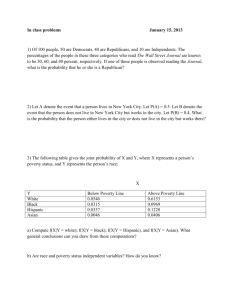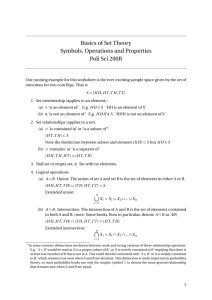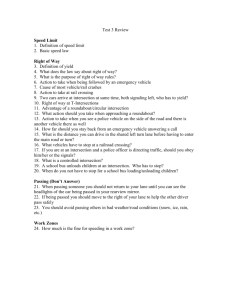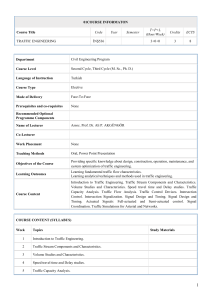Alternative intersections and Interchanges
advertisement
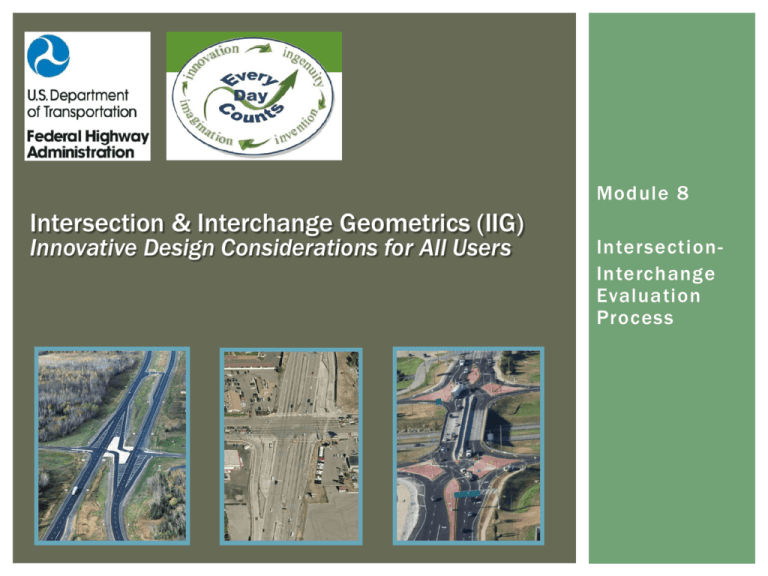
Module 8 Intersection & Interchange Geometrics (IIG) Innovative Design Considerations for All Users IntersectionInterchange Evaluation Process INTERSECTION CONTROL EVALUATION (ICE) Process to determine the “best” intersection design/traffic control for a given location All alternatives are considered An evaluation of safety, operational, financial and political impacts are compared HISTORICAL “DEFAULTS” Almost all intersection “problems” are solved by installing a traf fic signal Traffic Signal Warrants/Justification Separate process for other alternatives Historical default is to only consider traditional countermeaures traffic signal all way stop ICE PROCESS All alternatives are considered Initial screening for feasibility Technical Analysis Safety Capacity/Operations Costs – Benefit Costs Right of Way impacts Public/Political Considerations Selection of preferred alternative “Best” alternative Documented in report Subject to available funding, other projects, project readiness, etc BENEFITS OF ICE Quantification of “Best” alternative Decision is documented Potential for better decision making Important Criteria are analyzed Safety (quantitative) Capacity (quantitative) Construction, ROW and Maintenance Costs (quantitative) Political and Public acceptability (qualitative) MINNESOTA ICE Developed in 2007 with the desire to include roundabouts as an alternative to traf fic signals Safety and Capacity Analysis is required using acceptable methods Report documenting findings and recommendations must be submitted and approved by the District Traf fic Engineer http://www.dot.state.mn.us/trafficeng/safety/ice/ index.html WISCONSIN Facilities Development Manual 11-25-3 Intersection Control Evaluation ICE Worksheet Documents the technical and financial analysis of alternatives Project using Federal or State funding must complete the worksheet Two Phases (Scoping/Alternative Selection Decision is documented INDIANA Intersection Design Guide (2013) First a “need” must be determined to evaluate solutions to All alternatives are considered, including “no build” Decision Trees help determine feasibility, eliminate alternatives Safety, Capacity and Costs are all considered as well as other factors CALIFORNIA Traffic Operations Policy Directive (2013) Updates evaluation procedures for determining ef fective traf fic control strategies for subject intersection Assessment Phase – Identification of one or more strategies that will meet the “need” for control Engineering Analysis – Safety, Capacity and Life-Cycle Costs Establishment of District ICE coordinators All users are considered CALIFORNIA http://dot.ca.gov/hq/traffops/liaisons/ice.html SIX STEP METHODOLOGY Ch 10 Alternative Intersection Assessment FITS WITHIN EXISTING PROJECT DEVELOPMENT PROCESS • The needs identified in prior planning studies should “inform” (not dictate) the identification, development, and evaluation of intersection control and geometry concepts. • It is critical to understand the project context and intended outcomes prior to developing potential solutions so that options may be tailored to meet project needs within the opportunities and constraints of a given effort. Step 1 – Establish Objectives Having a clear understanding of the purpose and need is a fundamental step in evaluating alternatives “ Why are we building this project?” Stakeholder outreach is critical to developing meaningful and appropriate objectives Project goals and objectives (i.e. performance characteristics) should be specific, they should be measurable and directly relate to the purpose and needs Step 2 – Multi-modal User Assessment When considering intersection alternatives, integrate pedestrian, bicycle, and transit needs at an early stage of the project planning process. The unique characteristics of intersection options produce variations in the physical geometry and traffic control schemes which can introduce both benefits and challenges to pedestrians, bicyclists and transit users. Step 3 – ROW & Context Assessment • Assess the overall corridor (or isolated intersection) context including the built, natural, and community environment and the intended performance outcomes of the intersection form • Document the intended context, and how operations, safety, and geometry fit the context for each alternative including intended users (pedestrians, bicyclists, passenger cars, transit vehicles, freight, emergency responders, and over size/over weight vehicles) • Compare the ROW needs and economic impacts of practical alternatives Step 4 – Access Management Assessment Access management considerations: • Driveway spacing • Adjacent signal spacing • U-Turns STEP 5 – SKETCH LEVEL TRAFFIC ANALYSIS OPERATIONAL ANALYSIS TOOL OVERVIEW • Planning-level analysis, such as critical lane volume and Capacity Analysis for Planning of Junctions (CAP-X) • Highway Capacity Manual (HCM) Analysis • Microsimulation analysis Step 5 – Sketch Level Traffic Analysis CAP-X SPREADSHEET Step 6 – Detailed Traffic Analysis of Viable Alternatives Detailed traffic simulation analysis of the most promising alternatives QUALIT Y OF SERVICE Quality of service is defined as the perceived quality of travel by a road user. It is used in the 2010 HCM to assess multimodal level of service (MMLOS) for motorists, pedestrians, bicyclists, and transit riders. Quality of service may also include the perceived quality of travel by design vehicle users such as truck or bus drivers. INTERPRETING RESULTS Alt A Alt B i.e. Intersection Delay Performance Measure Hypothetical Cost-Effectiveness Graph of Four Alternatives Alt G Minimum Desirable LOS Alt R Cost QUESTIONS


